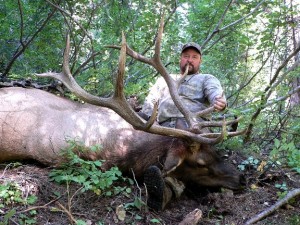Elk101.com – Elk Hunting Tip #2
If you followed along on Tip #3, you have located a bull and approached him in silence. You are now at the most critical point of the sequence. Your set-up. Think back to every time you have been busted by an elk. Or, try to remember everything that has ever gone wrong when you’re elk hunting. For me, I can attribute a very high percentage of our “un-successes” to our set-ups. Our set-ups aren’t always controllable, however. The wind can switch in an instant. The bull can stop behind a tree offering no shot. Our arrow can fall off the rest. The batteries in our rangefinder die. I could fill up all of this page and space in David Claycomb’s next article with the excuses and reasons why we didn’t get the bull. But when it comes right down to it, most of these reasons could fall under the generic classification of failures with our set-up.
How many times have you heard this story. A monster bull was screaming his head off, thrashing trees, double-bugling, glunking, slobbering. He was so fired up he would bugle every time a squirrel chattered. It was perfect. The hunter found a beautiful, open shooting lane and set up behind the last clump of brush on the edge of the opening. The hunter bugled and the bull came at a dead run, stopping broadside at 12 yards. Unfortunately, at full draw, the hunter had to watch as the bull walked off due to the fact that the clump of brush he was hiding behind was blocking an open shot.
Concealment in our set-up is critical, but it does no good to conceal ourselves to the point that we have no chance of getting a shot. The most critical thing to keep in mind with our set-up is (everyone should say it together…) making sure the wind is in your favor. If it’s not, you don’t have a set-up. You have just provided the bull with a very creative lesson on survival, but your set-up is over before it even starts. From there, find a place that will provide good shooting lanes. Unless you’re David Burdette and you’re comfortable shooting elk at 6 yards from inside the middle of an alder patch (more in self-defense than offense), find good, open shooting lanes. Anticipate the likely areas the bull will approach from (remember he will often circle downwind of the caller) and then set up in front of a clump of brush or a tree.

David Burdette's 2005 Idaho "alder-patch" Bull
Perhaps the single-most important piece of advice I can offer – the one thing that has added more success to our set-ups than any other thing – is to hunt with a partner. Become a team. Celebrate the success of the team and know that no matter if you were the caller or the shooter, you played a critical role in the outcome of the hunt, and the bull is as much one partner’s as it is the other’s. My good buddy Steve Chappell has a quote on his website by the great John Wooden that says “It is amazing how much can be accomplished if no one cares who gets the credit.” I couldn’t agree more with that statement. If you can find a hunting partner that shares that same philosophy, and apply some of these tactics we’ve discussed, not only will your successes increase but the level of satisfaction you feel after a successful hunt will be unparalleled.
Hunting with a partner allows one hunter to be the caller and one to be the shooter. The shooter should be 50-60 yards in front of the caller and should not give any indication to the
bull that he is there. He should blend into the surroundings in every way imaginable. He should become nothing. The caller’s job then becomes pulling the bull past the shooter, keeping the bull’s focus on himself, not the shooter.
As the shooter, it is important to become invisible. Remember the 3 critical senses that will get you busted: sight, sound, and smell. Blend in to your surroundings. When the bull comes in, don’t draw if he can see you. Wait for him to go behind a tree or turn his head. Don’t make any noise…you don’t want the bull to know where you are. If he knows where you are, even if he still thinks you’re an elk, he will be looking there for you and when he does, or does not, see you, he will be nervous. Again, keep the wind in your favor!
Keep in mind that the bull still has no idea you are there. Take a few minutes if necessary to make sure your set-up is right. You are in control at this point. Your success is hinging on your set-up. Don’t get in a hurry and seal the outcome before the real fun starts!
From here it’s easy. You’ve located a bull. You’ve silently moved in to within 100-120 yards of the bull and managed to stay completely undetected. You have a shooter 50-60 yards in front of the caller and your set-up is perfect. You’ve cleared a spot out at your feet to ensure you don’t break a branch when you draw your bow or move. You’ve ranged several landmarks around you so you know exactly how far away the bull is when he enters a shooting lane. All this, and the bull has no idea you are there. Now go back and re-read the calling sequence from Tuesday (Tip #4).
Remember, cow call, cut him off with a Challenge Bugle, draw your bow.

Corey's 2006 Idaho Bull
Tips #2-5 create the format for our hunts. It is not perfect. It won’t work everytime and it won’t work for everyone. It is not the “right” way nor the only way. But these tactics have increased our efficiency and success in the elk woods, especially the set-ups. They have been derived from the epicenter of elk hunting – tactics we employ when we’re in the middle of the game, when the moment of performance is at hand. They have been developed and refined through multiple failures. You have to be flexible and ready to adapt when the situation demands it. In my opinion, however, these tactics aren’t the most important. The most important tip I can offer when it comes to elk hunting starts long before the elk start bugling in September. Check back tomorrow for Elk1o1.com’s Elk Hunting Tip #1!
